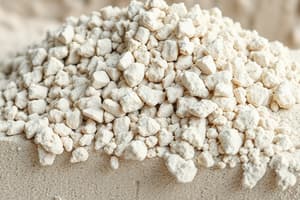Podcast
Questions and Answers
Organic binders are classified as non-hydraulic binders.
Organic binders are classified as non-hydraulic binders.
True (A)
In the compound WC-Co, Cobalt (Co) serves as the binding agent for the WC particles.
In the compound WC-Co, Cobalt (Co) serves as the binding agent for the WC particles.
True (A)
Hydraulic binders require water to harden.
Hydraulic binders require water to harden.
True (A)
Organic binders have poor coating properties and cannot be decomposed by photocatalytic reaction.
Organic binders have poor coating properties and cannot be decomposed by photocatalytic reaction.
Inorganic binders can be either metallic or ceramic, depending on the nature of the main material.
Inorganic binders can be either metallic or ceramic, depending on the nature of the main material.
Inorganic binders are decomposed by photocatalytic reaction.
Inorganic binders are decomposed by photocatalytic reaction.
Organic compounds have carbon-hydrogen covalent bonds.
Organic compounds have carbon-hydrogen covalent bonds.
Materials labeled as binders, such as cement, have low tensile strength.
Materials labeled as binders, such as cement, have low tensile strength.
Resins can bear compressive and tensile force.
Resins can bear compressive and tensile force.
Composite materials consisting of resin as the matrix and fiber as reinforcement have low tensile strength.
Composite materials consisting of resin as the matrix and fiber as reinforcement have low tensile strength.
Flashcards are hidden until you start studying




